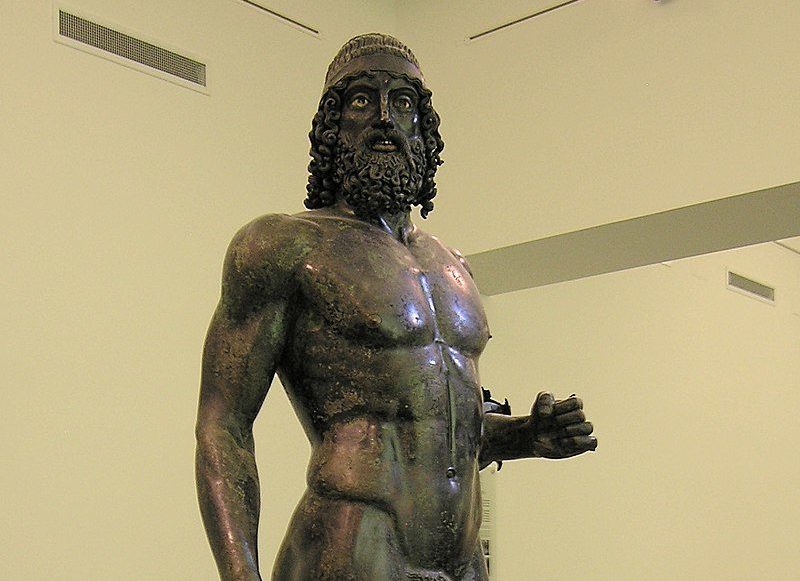
One famous ancient Greek statue discovered in the Ionian Sea off the coasts of southern Italy in 1972 was studied over the methodology by which it was created, some 2,500 years ago, and its teeth were confirmed to have been designed following the golden ratio of the ancient Greeks that is also used in modern-day dentistry.
Knowing that, at the time of the estimated origin of the so-called Riace Bronzes, the golden proportion principles which would guide classical art and concepts of aesthetic balance of the modern age were known and used, experts from the University of Sapienza in Rome, Italy, started their research in 2022.
The aim of this innovative study was to determine the dentofacial characteristics and the presence of golden ratios in the so-called “young-man” warrior statue, which features a precious and unique detail of its kind: silver foil to represent the upper teeth.
The research concluded that the design of this particular bronze statue indeed stems from the search for beauty as divine proportion, and revealed that even a relatively small detail such as the statue’s face and teeth seems to have been carefully programmed by its masterful ancient Greek sculptor following the mathematical value of 1:1.6181 to achieve the ideal harmonic proportions in human representations.
Although many studies have been conducted on the statues since their discovery, this is the first morphometric study to delve into their facial features.
Eerie pic of the discovery of the Riace bronzes, 1972. As if all they needed was to be gently led out of the sea … pic.twitter.com/SMsdQva2SA
— Rembrandt's R👀m 🖌 (@RembrandtsRoom) July 26, 2015
Archaeological importance of the Riace Bronzes
More than half a century after their discovery in the Ionian Sea near Riace Marina in 1972, the Riace Bronzes continue to fascinate and interest art enthusiasts and archaeology scholars.
The pair of statues was most likely sculpted in Greece between 450-460 BC, and are considered masterpieces of Classical Greek sculpture. The sculptor is not known, even if many are somewhat inclined to attribute the figures to the famous Greek sculptors Phidias or Myron.
They probably were lost at sea between the 1st to 2nd century BC when the ancient Romans looted large quantities of Greek artwork and transported them to present-day Italy.
Made of cast bronze, the favorite metal of Greek artists of classical antiquity, the two statues are among only twelve surviving ancient Greek bronze statues, because bronze was a material always in demand for reuse in later periods.
Ancient Greek golden ratio is the secret to harmonious smile until today
The two nude male figures, slightly larger than life size, represent two warriors. Various theories have been suggested about their identity.
The position of the body and the expression of the first statue’s face seem to convey the moment before a fight, in which the “young man” continues with a threatening attitude toward the second statue and a grin on his face that reveals his silver foil teeth.
Although the teeth are not completely exposed, they are sufficiently visible to evaluate some dimensional characters useful for further analysis, which prompted scientists from the Department of Anatomical, Histological, Forensic and Orthopedic Sciences to join forces with the Department of Computer Science and the Department of Medico-Surgical Sciences and Biotechnologies in raising a question of scientific, historical, and cultural interest on the original methodological framework by which the Riace bronzes were created, which to date no one had ever considered.
In fact, the same golden aesthetic proportion that was verified to have been applied in the creation of the 2,500 year-old statue’s face and teeth, still plays an important role in modern-day dentistry, as well as in figurative arts, the study observes.
“The factors that most affect smile aesthetics are the relationship of upper incisors in terms of respective length and width and the ratio of visible width of central incisors to lateral incisors and canines,” it describes.
“For a harmonious smile, the teeth must be proportional to each other but they must also be proportional to the face. Both the size and the shape of the teeth affect a good and balanced aesthetic appearance in relation to the face.”
Further studies, possibly carried out with direct measurements on statues or 3D models, could confirm the data and analysis of golden ratios that were reported by the University of Sapienza team of experts.
See all the latest news from Greece and the world at Greekreporter.com. Contact our newsroom to report an update or send your story, photos and videos. Follow GR on Google News and subscribe here to our daily email!



